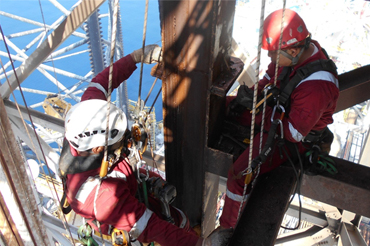DERRICK SURVEY
Derrick survey services involve thorough inspections of the derrick structure to assess its overall condition and structural integrity. Non-destructive testing Services such as ultrasonic testing, magnetic particle testing, and visual inspections are commonly used during derrick surveys to detect defects or flaws in the structure. Our Bolt torquing inspection is an important part of derrick surveys to ensure that bolts and fasteners holding the derrick structure together are properly tightened and secured. Derrick survey services may also include assessing the load capacity of the derrick structure to ensure that it can safely support the weight of drilling equipment, pipes, and other components during operations.

We are conducting Derrick surveys in accordance with API 4G CAT III Inspection. API 4G Cat III inspection services refer to the inspection and certification of derrick structures on offshore platforms based on the American Petroleum Institute (API) standards. API 4G Cat III inspection services ensure that the derrick structure on the offshore platform meets the requirements specified in the API 4G standard for Category III structures. API 4G Cat III inspection services involve a detailed examination of the derrick structure to assess its structural integrity and compliance with the API 4G standard. This includes visual inspections, non-destructive testing (NDT), bolt torquing inspection, load capacity assessment, and other specific inspection procedures.
MAST INSPECTION SERVICES
Mast inspection services at offshore rigs are crucial for ensuring the integrity, reliability, and safety of the mast structure on drilling rigs and platforms. Mast inspections at offshore rigs should be conducted regularly as part of routine maintenance and inspection programs. The frequency of inspections may vary based on the specific regulations, standards, and operating conditions of the rig, but typically, inspections are performed annually or bi-annually. We are providing various NDT Inspection methods for conducting mast inspections at offshore rigs, including visual inspections, ultrasonic testing, magnetic particle testing or dye penetrant testing and structural analysis. These methods help identify any defects, corrosion, cracks, or other issues that may compromise the structural integrity of the mast.
Following the inspection, a detailed report is prepared that outlines the inspection findings, NDT results, recommendations for repairs or maintenance, and a maintenance plan for addressing any identified issues. This report is essential for documenting the condition of the mast structure and planning for necessary repairs or improvements. Mast inspections at offshore rigs must comply with American Petroleum Institute (API), the International Maritime Organization (IMO), and other relevant organizations.
